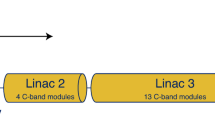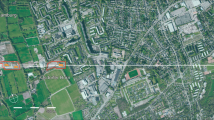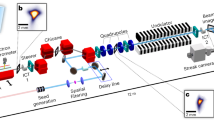Abstract
Single-pass free-electron lasers based on self-amplified spontaneous emission1,2,3,4 are enabling the generation of laser light at ever shorter wavelengths, including extreme ultraviolet5, soft X-rays and even hard X-rays6,7,8. A typical X-ray free-electron laser is a few kilometres in length and requires an electron-beam energy higher than 10 GeV (refs 6, 8). If such light sources are to become accessible to more researchers, a significant reduction in scale is desirable Here, we report observations of brilliant extreme-ultraviolet radiation from a 55-m-long compact self-amplified spontaneous-emission source, which combines short-period undulators with a high-quality electron source operating at a low acceleration energy of 250 MeV. The radiation power reaches saturation at wavelengths ranging from 51 to 61 nm with a maximum pulse energy of 30 µJ. The ultralow emittance (0.6π mm mrad) of the electron beam from a CeB6 thermionic cathode9 is barely degraded by a multiple-stage bunch compression system that dramatically enhances the beam current from 1 to 300 A. This achievement expands the potential for generating X-ray free-electron laser radiation with a compact 2-GeV machine.
This is a preview of subscription content, access via your institution
Access options
Subscribe to this journal
Receive 12 print issues and online access
$209.00 per year
only $17.42 per issue
Buy this article
- Purchase on Springer Link
- Instant access to full article PDF
Prices may be subject to local taxes which are calculated during checkout




Similar content being viewed by others
References
Bonifacio, R., Pellegrini, C. & Narducci, L. M. Collective instabilities and high-gain regime in a free-electron laser. Opt. Commun. 50, 373–377 (1984).
Milton, S. V. et al. Exponential gain and saturation of a self-amplified spontaneous emission free-electron laser. Science 292, 2037–2041 (2001).
Ayvazyan, V. et al. Generation of GW radiation pulses from a VUV free-electron laser operating in the femtosecond regime. Phys. Rev. Lett. 88, 104802 (2002).
Murokh, A. et al. Properties of the ultrashort gain length, self-amplified spontaneous emission free-electron laser in the linear regime and saturation. Phys. Rev. E 67, 066501 (2003).
Ackermann, W. et al. Operation of a free-electron laser from the extreme ultraviolet to the water window. Nature Photon. 1, 336–342 (2007).
Arthur, J. et al. Linac Coherent Light Source (LCLS) Conceptual Design Report SLAC-R593 (Stanford, 2002).
Tanaka, T. & Shintake, T. (eds) SCSS X-FEL Conceptual Design Report (RIKEN Harima Institute, Hyogo, Japan, 2005).
Altarelli, M. et al. (eds) XFEL: The European X-ray Free-Electron Laser, technical design report, preprint DESY 2006-097 (DESY, Hamburg, 2006).
Togawa, K. et al. CeB6 electron gun for low-emittance injector. Phys. Rev. ST Accel. Beams 10, 020703 (2007).
Elder, F. R., Gurewitsch, A. M., Langmuir, R. V. & Pollock, H. C. Radiation from electrons in a synchrotron. Phys. Rev. 71, 829–830 (1947).
LCLS. The First Experiments, SLAC-R611 (Stanford, 2000).
Schlenvoigt, H.-P. et al. A compact synchrotron radiation source driven by a laser-plasma wakefield accelerator. Nature Phys. 4, 130–133 (2008).
Lambert, G. et al. Injection of harmonics generated in gas in a free-electron laser providing intense and coherent extreme-ultraviolet light. Nature Phys. 4, 296–300 (2008).
Kitamura, H. Recent trends of insertion-device technology for X ray sources. J. Synchrotron Rad. 7, 121–130 (2000).
Saldin, E. L., Schneidmiller, E. A. & Yurkov, M. V. The Physics of Free Electron Lasers (Springer, Berlin, 1999).
Reiser, M. Theory and Design of Charged Particle Beams (Wiley, New York, 1994).
Shintake, T., Matsumoto, H., Ishikawa, T. & Kitamura, H. SPring–8 Compact SASE source (SCSS). Proc. SPIE 4500, 12–23 (2001).
Tanaka, H. et al. Low-emittance injector at SCSS. Proc. FEL 2006, 769–776 (2006).
Tanaka, T. FEL simulation code for undulator performance estimation. Proc. FEL 2004, 435–438 (2004).
Bonifacio, R., Salvo De, L., Pierini, P., Piovella, N. & Pellegrini, C. Spectrum, temporal structure and fluctuations in a high-gain free-electron laser starting from noise. Phys. Rev. Lett. 73, 70–73 (1994).
Hara, T. et al. Cryogenic permanent magnet undulators. Phys. Rev. ST Accel. Beams 7, 050702 (2004).
Yabashi, M. et al. Photon optics at SCSS. Proc. FEL 2006, 785–792, (2006).
Wang, D. X., Krafft, G. A. & Sinclair, C. K. Measurement of femtosecond electron bunches using a rf zero-phasing method. Phys. Rev. E 57, 2283–2286 (1998).
Acknowledgements
The authors express special thanks to the staff of SPring–8, in particular to T. Hasegawa and S. Tanaka for machine operation, S. Kojima, S. Indo and K. Nakashima for their technical support, H. Tomizawa for his outstanding insights, and H. Suematsu, N. Kumagai and H. Ohno for their continuous encouragement. We also thank H. Matsumoto and H. Baba for developing the C-band accelerator system.
Author information
Authors and Affiliations
Corresponding authors
Supplementary information
Supplementary Information
Supplementary Figures S1–S6 (PDF 206 kb)
Rights and permissions
About this article
Cite this article
Shintake, T., Tanaka, H., Hara, T. et al. A compact free-electron laser for generating coherent radiation in the extreme ultraviolet region. Nature Photon 2, 555–559 (2008). https://doi.org/10.1038/nphoton.2008.134
Received:
Accepted:
Published:
Issue Date:
DOI: https://doi.org/10.1038/nphoton.2008.134
This article is cited by
-
Scheme for generating 1 nm X-ray beams carrying orbital angular momentum at the SXFEL
Nuclear Science and Techniques (2020)
-
A compact and cost-effective hard X-ray free-electron laser driven by a high-brightness and low-energy electron beam
Nature Photonics (2020)
-
Comparative Analysis of Phenomenological and Numerical Modeling of Experimentswith Single-Pass Free-Electron Lasers
Radiophysics and Quantum Electronics (2019)
-
Nanofocusing of X-ray free-electron laser using wavefront-corrected multilayer focusing mirrors
Scientific Reports (2018)
-
2.856 GHz microwave signal extraction from mode-locked Er-fiber lasers with sub-100 femtosecond timing jitter
Nuclear Science and Techniques (2018)



